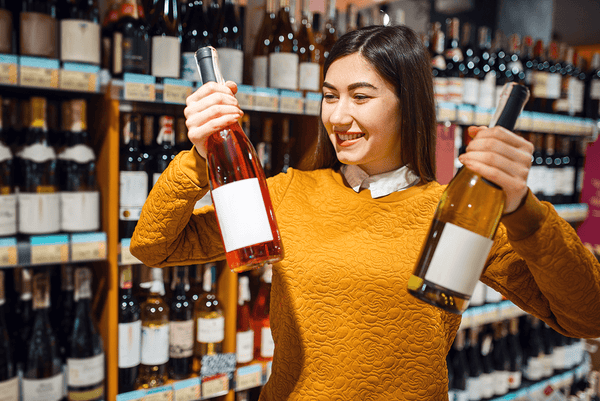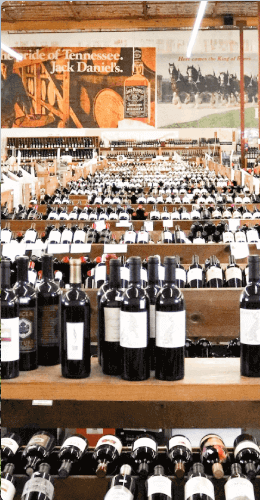How to Choose a Good Bottle of Wine Online or at a Store?

Surely, at some point, you’ve felt like a person lost in a maze while in a wine shop or even perusing the pages of Bottle Barn’s well-organized online wine store. Wine can seem intimidating, and you should never hesitate to reach out to our friendly and knowledgeable staff when making wine buying decisions.
But choosing a good bottle of wine should be a frequent but exciting challenge. It’s a common experience when faced with labels that seem written in another language, offering details that only add to the confusion.
Let’s delve into how to choose a good bottle of wine starting with zero knowledge, first in you are in physical store, and second if you want to buy wine online.
Points to Consider While Buying A Wine Bottle
Starting with the bottle shape and the label, a wine bottle can provide valuable information to help you make the right choice. Here are some clues.
The Shape of the Bottle
At first glance, the shape of the bottle might not seem very revealing. However, the size and thickness of the glass can offer practical hints. Compare the classic Bordeaux (with shoulders), like the Katherine Goldschmidt Stonemason Hill Cabernet Sauvignon, the traditional Burgundy bottle (without shoulders), like the Domaine Robert Chevillon Bourgogne Rouge, and typical Alsace bottle (tall and slim with no shoulders), like the Fetzer Riesling. In a broad sense, you can expect Bordeaux bottle to contain heartier wines; Burgundy bottles to contain lighter, fruiter wines; and Alsace bottles to contain light, fruity, and probably sweeter wines. In addition, a heavy bottle made of thick glass often signals quality.
This is certainly the case for Champagne bottles, designed to hold sparkling wines under substantial pressure. Take a look at the Iron Horse Classic Vintage Brut, for example.
Many wineries choose heavier glass for their premium wines to convey a sense of gravitas and prestige. This feature, however, is now changing because many excellent winemakers are using lighter glass to cut down on CO2 emissions; so keep that in mind.
The Size of the Bottle
A standard bottles of wine contains 75 cl. Thought it was a full liter? That’s a common misconception. You’ll also find half bottles (37.5 cl) and magnums (1500 cl.), though they’re less common. Producers prefer selling larger quantities and also worry about too much oxygen inside smaller bottles, which can negatively affect long-term aging. Still, remember that you can find different bottle sizes to suit different occasions!
For extended aging, experts recommend the magnum because the ratio of wine to oxygen in this size is optimal. Consider this when buying a wine you love, especially if you’re planning an event. Buying a magnum can also be a great value; consider the Sorelle Bronca Extra Dry Prosecco 1.5L, for example. Magnums offer the best preservation unless cork taint occurs, in which case the problem will be proportionally larger. Bottles larger than 1.5 liters are mainly for the hospitality industry or showmanship.
The Label and Back Label
The front label serves as the wine’s calling card—not just for aesthetics but for information. A well-designed label can convince you to buy or make you hesitate. A good layout, accurate mentions, and an engaging description make all the difference.
European wine labels focus on appellations and geographic regions rather than grape varieties, terroir, or climate, which are emphasized in wines from other regions. Europeans assume the buyer is familiar with these appellation details, which can be risky. Usually, the front label lists the wine’s name and vineyard location. Additional production details and mandatory information are found on the back label.
The Wine’s Alcohol Content
Alcohol percentage, listed by law, can guide your choice and help you avoid making your guests a bit too tipsy. A wine with 15% alcohol is stronger than one with 13%. Most still wines range between 13% and 14.5%, though wines from warmer regions can reach 15.5% or 16%. With global climate change, higher alcohol wines are increasingly common.
Sparkling wines and many white wines hover around 12%, while fortified wines like Sherry or Port exceed 16%, sometimes reaching 20%. Remember, in many cases, the lower the alcohol level, the sweeter the wine. And those Alsace bottle shapes will help lead you to less dry wines.
Modern trends favor lower-alcohol wines that retain flavor and character, appealing to health-conscious consumers. You can find many low alcohol wines at the best online wine store, Bottle Barn.
Other Useful Indicators When You Purchase Wine Online
While buying wine online, you will also want to consider the following, which may appear in the description:
Vintage Year
While not mandatory worldwide, the vintage is valuable when it appears, as it reflects the wine’s harvest year. A quick online search can reveal whether the year was good or bad for the region.
Contains Sulfites
It is required on labels, though nearly all wines contain sulfites.
Production Details
Mentions like "oak-aged," "old vines," or "lees-aged" highlight specific wine characteristics.
Sweetness in Sparklers
Terms like Brut, Demi-sec, dry, or sweet indicate sugar levels. Remember, for example that even Riesling wines come in dry versions, and that is usually indicated on the label, like the Ridgecrest Estate Dry Riesling. You can find sweetness charts for sparkling wines online.
Great online wine stores like Bottle Barn have extremely well organized websites designed to make online wine purchases easy and knowledgeable. You can sort by country, appellation, price per bottle, and grape variety. We also have special collections that are great for browsing different wines, like “best value,” “natural wines,” biodynamic, and vegan friendly. You will also find a Fine and Rare section, perfect for locating a gift or starting a cellar!


















Leave a comment